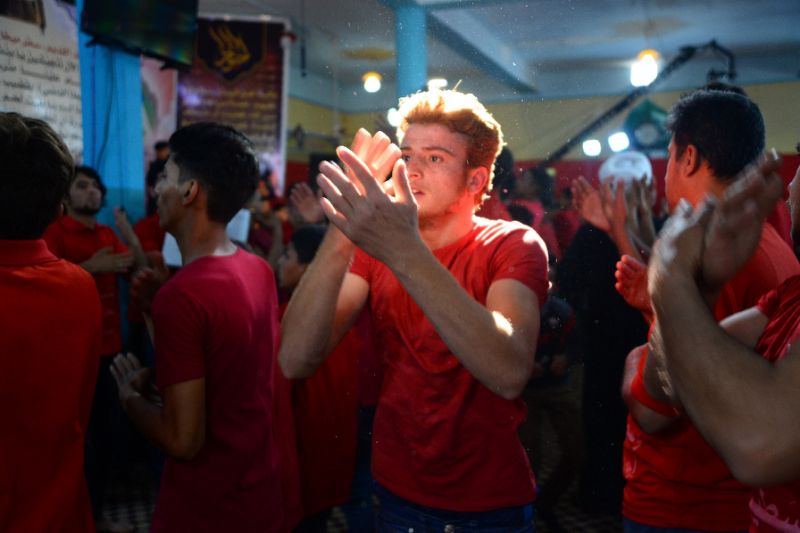In Iraq, religious rap meets a chorus of controversy

In parts of conservative Iraq, a religious movement within the Shiite sect has adapted the traditional "latmiyat" -- chanted verses mourning Muslim icons -- to Western-style rap in an effort to keep youth interested in religion (AFP Photo/Haidar HAMDANI)
Midhatiya (Iraq) (AFP) - As the black-clad rapper spat lyrics into the microphone on stage, the Iraqi boys below beat their chests in mourning. He was, after all, paying homage to slain Shiite figurehead Hussein.
The ear-splitting drums reverberated around the hall as Iraqi teenagers shouted back rhymes venerating the Prophet Mohammad's grandson and other honoured figures in Islam.
In parts of conservative Iraq, a religious movement within the Shiite sect has adapted the traditional "latmiyat" -- chanted verses mourning Muslim icons -- to Western-style rap in an effort to keep youth interested in religion.
It appears to be working.
In Midhatiya, a town roughly 100 kilometres (60 miles) south of Baghdad, teens in matching red shirts stood shoulder to shoulder in their local place of worship as if preparing for prayer.
But when the speakers crackled to life, they blared a staccato drum beat and the voice of a young performer in a black robe, rhyming with a speed befitting New York's fiercest underground rap battles.
Even the elderly religious figures along the back wall swayed to the rhythm, including Sheikh Salem al-Janahi.
He hails from the Mahmoud al-Sarkhi movement, which has championed "Husseini" rap and is therefore regularly accused of distorting conservative traditions.
Straining to make himself heard over the loud music, Janahi told AFP that his more traditional counterparts "had gotten involved in corruption and politics, so young people began running away from religion."
- Rhyming for religion -
Religion and politics are deeply intertwined in Iraq, where government posts have been allocated according to sect since the US-led invasion in 2003.
The country's 40 million people are mostly Shiites, with a burgeoning youth population navigating an increasingly modern, Westernised society.
That, said "Husseini" rapper Karrar al-Bederi, is exactly why this hybrid style of worship is necessary.
"Young people abandoned religion and morality because of backwards, classical clerics," Bederi said.
In comments to AFP peppered with Quranic verses, he said that the refusal to meet young Muslims halfway had turned the youth towards "crime, drug use, ignorance and atheism."
To fight this, he and fellow Muslims appropriated rap -- usually associated with the "invader" United States -- to create a religiously-focused form of worship.
"It has become one of the important ways we reach out to youth, to spread a message of peace, moderation, but morals as well," said Bederi.
It has also brought social media stardom to some performers, whose modernised "latmiyats" have earned them tens of thousands of online views.
One video published on Facebook showed a rapper in jeans and a cap, standing in a grassy field featuring a tall date palm -- Iraq's national tree.
"My Lord is unrivalled, he taught me to act with respect. I want to talk about the cause of our imam," he sang.
In other footage, men in green appeared to enter a trance, slamming their chests faster and faster to an electronic tune.
- 'Deviant movements' -
But even as they electrify crowds, the raps spark anger among clerics, shocked to see traditional psalms so distorted in Iraq's rural south.
Shiite Imam Latif al-Amidi, for one, is not a fan.
"Religious deviant movements that have emerged recently have taken advantage of weak religious knowledge among young people to introduce to Islam things that have nothing to do with religion," Amidi told AFP.
"These movements brought singers, dancing and DJs into Islam, using the excuse that they want to attract youth."
Aside from "anasheeds," which are hymns performed without instruments, the permissibility of music in Islamic worship is disputed.
Hardline clerics say Islam forbids all music, even in daily life outside the mosque.
But other Muslim movements use drums and dance in their worship, including Iraq's Sufis.
The "latmiyat" themselves predate Islam, going back around 4,000 years to Iraq's Babylonian history, but have their own icons in modern-day Iraq, including Bassem al-Karbalai.
Iraq's Shiite authorities have yet to issue a religious ruling (fatwa) on whether the rapped "latmiyat" is acceptable according to Shiite dogma.
The format has never been performed or used as a style of worship in the country's two main Shiite holy cities, Najaf and Karbala.
That has not deterred Bederi however, who told AFP: "We have to address young people with the tools they know."